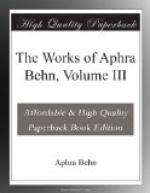p. 212 this old Sir Guy of Warwick. Sir Guy of Warwick is an old slang name for a sword; a rapier. The name is taken from the romance (of which there were many versions) and which proved extraordinarily popular. It was first licensed ‘in prose by Martyn Parker’ to Oulton, 24 November, 1640. Smithson’s version was first printed in black letter, and a second edition appeared in 1686. John Shurley’s version was published 4to, 1681 and again 1685. Esdalle, English Tales and Romances, enumerates sixteen versions, editions and abridgements, concluding with ’The Seventh Edition’ 12mo, 1733.
p. 214 Enter Bredwel. Lady Fulbank supplying Gayman with money through the medium of Bredwel ‘drest like a Devil’ is reminiscent of incidents in Dryden’s first comedy, The Wild Gallant (1663, and revised version, 1667; 4to, 1667), where Lady Constance employs Setstone, a jeweller, to accomodate Loveby with ready cash. Loveby is benefited to the tune of two hundred and fifty pounds, which are filched from the study of old Lord Nonsuch, who complains in much the same way as Sir Cautious. Loveby declares it must be the devil who has enriched him, and forthwith rescues his ‘Suit with the Gold Lace at Sleeves from Tribulation.’ Owing to his poverty he has been unable to visit Constance, and when he appears before her in his gay clothes he excuses his fortnight’s absence by saying, I have been ’out of Town to see a little thing that’s fallen to me upon the Death of a Grandmother.’ In Act i of The Wild Gallant Loveby gives Bibber a humorous description of a garret, which may be paralleled with Bredwel’s ‘lewd’ picture of Cayman’s chamber—The Lucky Chance, Act i, II. It must be allowed that Mrs. Behn bears away the palm in this witty passage. The Wild Gallant is, by Dryden’s own confession (cf. the First Prologue), founded on a Spanish plot. In the Preface he says: ’The Plot was not Originally my own: But so alter’d by me, (whether for better or worse, I know not) that, whoever the Author was, he could not have challeng’d a Scene of it.’ So vast, indeed, is the library of the Spanish Theatre that it has not as yet been identified, a task which in view of the author’s own statement may well be deemed nigh impossible. Recent critics have pertinently suggested that the device of furnishing Loveby with money was the chief hint for which Dryden is indebted to Spain. The conduct of the amour between Lady Fulbank and Gayman, founded as it is on Shirley’s The Lady of Pleasure, has nothing in common with Otway’s intrigue between Beaugard and Portia—The Atheist (1683)—which owes itself to Scarron’s novel, The Invisible Mistress.
p. 222 the Gad-Bee’s in his Quonundrum. Gad-Bee, vide supra. The False Count, Act ii, II (p. 129), note, p. 481. Quonundrum or Conundrum. A whim; crotchet; maggot; conceit. The N.E.D. quotes this passage, cf. Jonson’s Volpone, Act v, sc. II: ‘I must ha’ my crotchets! And my conundrums!’ Dic. Cant. Crew (1700) has: ‘Conundrums. Whimms, Maggots and such like.’




